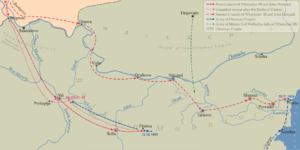Crusade of Varna
It was called by Pope Eugene IV on 1 January 1443 and led by King Władysław III of Poland, John Hunyadi, Voivode of Transylvania, and Duke Philip the Good of Burgundy.
In 1428, while the Ottoman Empire was fighting a war with the Republic of Venice and the Kingdom of Hungary they achieved a temporary peace by establishing the Serbian Despotate as a buffer state.
[6] John Hunyadi aided Władysław's cause by pacifying the eastern counties, gaining him the position of Nádor of Transylvania and the corresponding responsibility of protecting Hungary's southern border.
[5] The Catholic Church had long been advocating for a crusade against the Ottomans, and with the end of both the Hungarian civil war and a nearly simultaneous one in Byzantium, they were able to begin negotiations and planning realistically.
[4] He nearly annihilated Mezid Bey's army in Transylvania on 22 March 1442, and in September he defeated the revenge attack of Şihabeddin Pasha, governor-general of Rumelia.
War was proclaimed against Sultan Murad II at the diet of Buda on Palm Sunday 1443, and with an army of 40,000 men, mostly Magyars, the young monarch, with Hunyadi commanding under him, crossed the Danube and took Nish and Sofia.
They correctly expected that Murad would not be able quickly to mobilize his army, which consisted mainly of fief-holding cavalrymen (timariots) who needed to collect the harvest to pay taxes.
[5] In the Battle of Nish the crusaders were victorious and forced Kasim Pasha of Rumelia and his co-commander Turahan Bey to flee to Sofia, Bulgaria to warn Murad of the invasion.
As they marched home, however, they ambushed and defeated a pursuing force in the Battle of Kunovica, where Mahmud Bey, son-in-law of the Sultan and brother of the Grand Vizier Çandarlı Halil Pasha, was taken prisoner.
[5] Murad, meanwhile, returned angry and dejected by the unreliability of his forces, and imprisoned Turahan after blaming him for the army's setbacks and Mahmud Bey's capture.
Among other things, his vizier's sister begged him to obtain her husband Mahmud's release, and his wife Mara, daughter of Đurađ Branković, added additional pressure.
[5] On 24 April 1444, Władysław sent a letter to Murad, stating that his ambassador, Stojka Gisdanić, was travelling to Edirne with full powers to negotiate on his behalf.
Although Pius II officially declared a three-year crusade at the Council of Mantua to recapture Constantinople from the Ottomans, the leaders who promised 80,000 soldiers to it reneged on their commitment.
